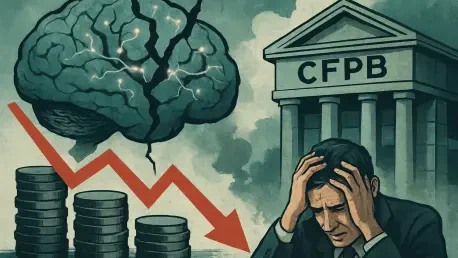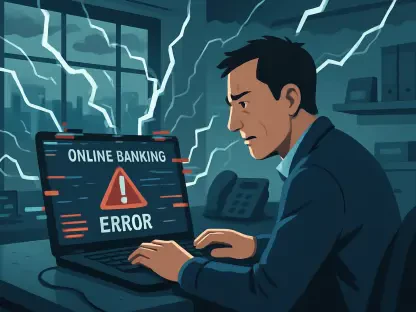What happens when the money you rely on for daily expenses or savings suddenly vanishes without a trace, leaving you in financial distress? For over 100,000 consumers, this nightmare became reality when Synapse Financial Technologies, a key player in the fintech world, collapsed, freezing a staggering $265 million in funds. This crisis has shaken trust in digital financial platforms, leaving countless individuals stranded and desperate for answers. The Consumer Financial Protection Bureau (CFPB) has emerged as a critical force in this unfolding drama, fighting to reclaim lost money and expose the cracks in the fintech ecosystem.
Why Synapse’s Fall Shook the Fintech World
The collapse of Synapse, a middleware provider that connected fintech apps with banks, sent shockwaves through the industry when it filed for bankruptcy last year. An estimated $60-90 million in consumer funds remain unrecovered, a direct result of chaotic record-keeping and inadequate coordination with partners like Evolve Bank and fintech platforms such as Yotta and Juno. For users who depended on these apps for managing savings or making payments, the fallout has been devastating, turning convenience into catastrophe overnight.
This debacle has exposed glaring vulnerabilities in the fintech sector, where rapid innovation often outpaces oversight. Consumers, drawn by the promise of seamless digital banking, now face the harsh reality that their money may not be as secure as assumed. The scale of this financial disruption has turned heads, prompting urgent questions about how such a breakdown could occur in a supposedly cutting-edge industry.
CFPB’s Aggressive Push for Accountability
The CFPB has launched a multi-pronged offensive to address Synapse’s failures and mitigate the harm to consumers. One key move involves preparing an adversary proceeding complaint, targeting the company’s unfair practices and alleging that sloppy ledger management directly led to massive losses. This legal action aims to hold Synapse accountable for the chaos it unleashed on unsuspecting users.
Beyond the courtroom, the bureau advocated earlier this year to shift Synapse’s bankruptcy from Chapter 11 to Chapter 7, arguing that liquidation could accelerate compensation for affected individuals. A crucial hearing on this motion is expected to shape the pace of recovery. Meanwhile, the CFPB is exploring its civil penalty fund, which holds an unallocated balance of $118.9 million as of recent reports, as a potential lifeline to repay victims without relying on Synapse’s diminished assets.
In parallel, efforts to recover critical data are underway, with the CFPB supporting Evolve Bank and firms like GlassRatner and Ankura in extracting financial records from Synapse’s Amazon Web Services environment. This painstaking process is essential for tracing missing funds and rebuilding trust. Together, these strategies reflect a determined effort to tackle both immediate consumer pain and deeper systemic flaws.
Voices of Frustration and Resolve in the Crisis
From the frontlines of this financial mess, powerful voices are shedding light on the human toll. Jelena McWilliams, Synapse’s Chapter 11 trustee and former FDIC Chair, has been instrumental in aiding the CFPB’s investigation, providing vital data since a pivotal hearing earlier this year. Her collaboration underscores a shared commitment to untangling the complex web of misplaced funds and ensuring some measure of justice.
The CFPB has also highlighted the flood of grievances from consumers, with hundreds of complaints pouring in from users of Synapse-linked fintech platforms. These individuals, unable to access their accounts or recover even partial funds, paint a grim picture of financial limbo. One regulator remarked, “This situation reveals a critical blind spot in fintech—middleware providers must be held to the same rigorous standards as traditional banks.”
Stakeholders across the board, from industry experts to consumer advocates, agree on the need for stricter oversight. The consensus is clear: without transparency and accountability, similar crises will continue to erode public confidence. These perspectives drive home the urgency of not just resolving this case but preventing future disasters in a rapidly growing sector.
Unpacking the Roots of Synapse’s Failure
Delving deeper into the collapse, the root causes point to systemic negligence rather than mere bad luck. Synapse’s inability to maintain accurate ledgers meant that funds could not be properly tracked or transferred, a problem worsened by poor communication with banking partners. This “gross mismanagement,” as described by some analysts, left consumers caught in a financial black hole with no clear path to recovery.
The ripple effects touched multiple fintech apps, including Mercury and Copper, disrupting services for users who had little warning of the impending crisis. Such widespread impact raises alarms about the fragility of middleware providers, often invisible to end-users but central to the flow of money. This case serves as a stark lesson on the risks of unchecked growth in fintech without robust safeguards.
Steps Consumers and Fintechs Can Take Amid Uncertainty
While the CFPB spearheads the fight for recovery, consumers and fintech companies aren’t powerless. Keeping meticulous records of transactions, account statements, and any correspondence with Synapse-linked platforms is crucial for strengthening claims in the ongoing process. Detailed documentation can make a significant difference when funds are finally disbursed.
Filing formal complaints through the CFPB’s online portal is another vital step, ensuring individual cases are logged and prioritized. For both users and businesses, diversifying financial operations across multiple providers can reduce the risk of total loss if one platform fails. Staying updated on bankruptcy proceedings and agency announcements is equally important, as upcoming decisions could directly impact recovery timelines. These proactive measures offer a way to navigate the uncertainty while awaiting resolution.
Reflecting on a Hard-Fought Battle for Justice
Looking back, the CFPB’s relentless pursuit of accountability in the Synapse debacle marked a turning point for consumer protection in fintech. Their legal maneuvers, data recovery efforts, and potential use of penalty funds demonstrated a firm resolve to right the wrongs suffered by thousands. This saga underscored the fragility of trust in digital finance and the dire consequences of oversight failures.
Moving forward, affected consumers were encouraged to remain vigilant, maintaining records and engaging with regulatory channels to secure their rightful claims. Fintech firms, on the other hand, faced pressure to adopt stricter internal controls and diversify partnerships. The broader industry stood at a crossroads, compelled to prioritize transparency to rebuild confidence. Ultimately, this case served as a catalyst for stronger regulations, ensuring that innovation no longer came at the expense of consumer security.









